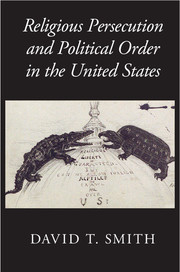Book contents
- Frontmatter
- Dedication
- Contents
- Acknowledgments
- 1 Introduction
- 2 Religious freedom and persecution in America: A theoretical overview
- 3 Joseph Smith and the rise of Mormonism: The political threat of religious charisma
- 4 The federal response to Mormonism
- 5 Jehovah's Witnesses and the flag salute, 1870–1940
- 6 Mass violence against Jehovah's Witnesses, 1940–1942
- 7 The Catholic experience in America
- 8 The Jewish experience in America
- 9 The Islamic experience in America
- 10 Conclusion
- Sources and bibliography
- Index
7 - The Catholic experience in America
Published online by Cambridge University Press: 05 November 2015
- Frontmatter
- Dedication
- Contents
- Acknowledgments
- 1 Introduction
- 2 Religious freedom and persecution in America: A theoretical overview
- 3 Joseph Smith and the rise of Mormonism: The political threat of religious charisma
- 4 The federal response to Mormonism
- 5 Jehovah's Witnesses and the flag salute, 1870–1940
- 6 Mass violence against Jehovah's Witnesses, 1940–1942
- 7 The Catholic experience in America
- 8 The Jewish experience in America
- 9 The Islamic experience in America
- 10 Conclusion
- Sources and bibliography
- Index
Summary
INTRODUCTION
Catholics were historically a large but marginal minority in American civic life. At the time the United States was founded, several states denied Catholics access to political office. These prohibitions dissolved within a few decades, but anti-Catholic prejudice did not. The election of John F. Kennedy in 1960 marked only the second time in history a Roman Catholic had secured the presidential nomination of a major party. Even Kennedy's election did not represent the transcendence of the sectarian divide. According to the American National Election Study, Kennedy won the support of 81.7 percent of Catholics but just 37.6 percent of Protestants, a religious gap of 45 percentage points that has never come close to being repeated. In 1959, 25 percent of Americans said they would not vote for a Catholic presidential candidate of their own party; the figure had been 30 percent when Gallup first asked the question in 1937.
Despite Protestant distrust of Catholics, Catholics were not subject to the same kind of persecution in the United States as Mormons or Jehovah's Witnesses. This is not to say that Catholics never suffered violence, or that their political rights were never threatened. In the 1830s, arson against Catholic properties in New England was so widespread that insurance companies refused to places policies on Catholic buildings made of noninflammable materials. The 1850s saw several lethal election riots between Catholics and Protestants. However, Catholics ultimately enjoyed the protection of the state. Governors and federal authorities acted quickly to put an end to anti-Catholic violence, which was spasmodic rather than sustained. In the mid-nineteenth century, Nativists took political power in several states and cities with ambitious schemes for the exclusion of Catholics from the polity. They managed to enact symbolic and often insulting anti-Catholic measures such as instituting state inspections of convents, but failed to achieve their most prized legislation of extending the waiting period for naturalization to twenty-one years. Catholics continued their slow but steady process of incorporation into the United States.
- Type
- Chapter
- Information
- Religious Persecution and Political Order in the United States , pp. 151 - 165Publisher: Cambridge University PressPrint publication year: 2015



